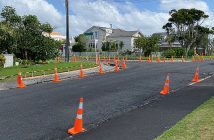Road markings indicating speed limit changes can help drivers stick to the limit and improve road safety, researchers from the University of Waikato say

Instead of just a road sign that marks when speed limits change, in their driving simulator, the researchers trialled how participants drove in speed zones of 60km/h, 80km/h, and 100km/h which had different line markings.
Drivers in the simulation who saw the markings were better at sticking to the speed limit than those in the control group who weren’t shown the markings.
The markings worked even when the drivers weren’t told what they meant and were even more effective once drivers were familiar with them.
The potential for using road markings to indicate speed limits was investigated in a driving simulator over the course of two sessions.
Two types of experimental road markings, an “Attentional” set designed to provide visually distinct cues to indicate speed limits of 60, 80 and 100 km/h, and a “Perceptual” set designed to also affect drivers’ perception of speed, were compared to a standard undifferentiated set of markings.
Twenty participants per group were assigned to one of four experimental groups (Attentional Explicit, Attentional-Implicit, Perceptual-Explicit, Perceptual-Implicit) or a Control group of 22, who followed standard road markings.
The Explicit groups were instructed about the meaning of the road markings while those in the Implicit and Control groups did not receive any explanation.
Participants drove five 10 km simulated roads containing three speed zones (60, 80 and 100 km/h) during the first session.
The participants returned to the laboratory approximately three days later to drive five more trials including roads they had not seen before, a trial that included a secondary task, and a trial where speed signs were removed and only markings were present.
The findings indicated that both types of road markings improved drivers’ compliance with speed limits compared to the control group, but that explicit instruction as to the meaning of the markings was needed to realise their full benefit.
Although previous research has indicated the benefit of road markings used as warnings to indicate speed reductions in advance of horizontal or vertical curves, the findings of the present experiment also suggest that systematically associating road markings with specific speed limits may be a useful way to improve speed limit compliance and increase speed homogeneity.
The 60km/h had dotted line for centre and edge, 80km/h looked like normal roads with dotted centre line and continues edge lines, and 100 km/h had a green line down the centre.




